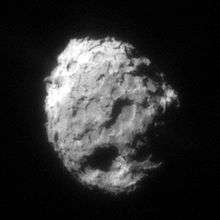C/2000 U5
| Discovery | |
|---|---|
| Discovered by | LINEAR 1.0-m reflector (704)[1] |
| Discovery date | October 29, 2000 |
| Orbital characteristics A | |
| Epoch |
December 15, 2000 (JD 2451893.5) |
| Aphelion | N/A |
| Perihelion | 3.4861 AU (q) |
| Semi-major axis | −652.38 AU[2][lower-alpha 1] |
| Eccentricity |
1.0052[2] 1.0057 (epoch 2008+)[3] |
| Orbital period | N/A |
| Inclination | 93.652° |
| Last perihelion | March 13, 2000[2] |
| Next perihelion | ejection |
C/2000 U5 (LINEAR) is a single-apparition comet discovered on October 29, 2000, by Lincoln Near-Earth Asteroid Research.[1] The comet has an observation arc of 362 days[2] allowing a good estimate of the orbit. C/2000 U5 is, as of 2015, the 13th most hyperbolic comet ever discovered and will leave the Solar System.
Before entering the inner Solar System for a 2000 perihelion passage, C/2000 U5 had a barycentric (epoch 1960-Jan-01) orbit with an apoapsis distance of 5,473 AU, and a period of approximately 143,000 years.[3]
The comet came to perihelion on March 13, 2000.[2] As the comet was leaving the inner Solar System, it passed within 0.766 AU of Jupiter on February 3, 2001,[4] Since an epoch of 2000-Dec-06, C/2000 U5 has had a barycentric eccentricity greater than 1,[3] keeping it on a hyperbolic trajectory that will eject it from the Solar System. In 2029, when it is more than 50 AU from the Sun and beyond the influence of the planets, it will still have a barycentric eccentricity of 1.0057.[3]
Comet C/1980 E1 has an even greater eccentricity.
Notes
- ↑ C/2000 U5 is on an escape trajectory out of the Solar System, i.e. it has a hyperbolic orbit. For a hyperbolic orbit the semi-major axis is still defined, but is negative. This value cannot be interpreted as average distance from the Sun. The orbital energy is inversely proportional to negative semi-major axis. Objects in hyperbolic orbits have negative semi-major axis, giving them a positive orbital energy.
References
- 1 2 Brian G. Marsden (2000-11-01). "MPEC 2000-V02 : COMET C/2000 U5 (LINEAR)". IAU Minor Planet Center. Retrieved 2011-03-12.
- 1 2 3 4 5 "JPL Small-Body Database Browser: C/2000 U5 (LINEAR)" (last observation: 2001-10-26; arc: 362 days). Jet Propulsion Laboratory. Retrieved 2011-03-12.
- 1 2 3 4 Horizons output. "Barycentric Osculating Orbital Elements for Comet C/2000 U5 (LINEAR)". Retrieved 2011-03-12. (Solution using the Solar System Barycenter and barycentric coordinates. Select Ephemeris Type:Elements and Center:@0)
- ↑ "JPL Close-Approach Data: C/2000 U5 (LINEAR)" (last observation: 2001-10-26; arc: 362 days). Retrieved 2010-03-12.
External links
- Orbital simulation from JPL (Java) / Horizons Ephemeris

